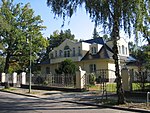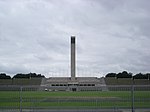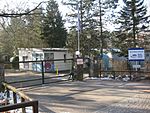Berlin 1939–1945 War Cemetery
Cemeteries in BerlinCommonwealth War Graves Commission cemeteries in GermanyWorld War II cemeteries in Germany

The Berlin 1939–1945 War Cemetery is one of two Commonwealth War Graves Commission (CWGC) cemeteries in Berlin, the other being the World War I Berlin South-Western Cemetery in Stahnsdorf, Brandenburg. The Berlin 1939–1945 War Cemetery was established in 1945 as a central burial ground for aircrew and prisoners of war who were interred in the Berlin area and in East Germany. There are also 260 burials from the post-war British Occupation Authorities staff, or their relatives. Of the wartime burials, about 80% are aircrew, killed in action over Germany: the remainder are prisoners of war.
Excerpt from the Wikipedia article Berlin 1939–1945 War Cemetery (License: CC BY-SA 3.0, Authors, Images).Berlin 1939–1945 War Cemetery
Heerstraße, Berlin Westend
Geographical coordinates (GPS) Address Nearby Places Show on map
Geographical coordinates (GPS)
| Latitude | Longitude |
|---|---|
| N 52.507222222222 ° | E 13.221111111111 ° |
Address
Stone of Remembrance
Heerstraße
14055 Berlin, Westend
Germany
Open on Google Maps










